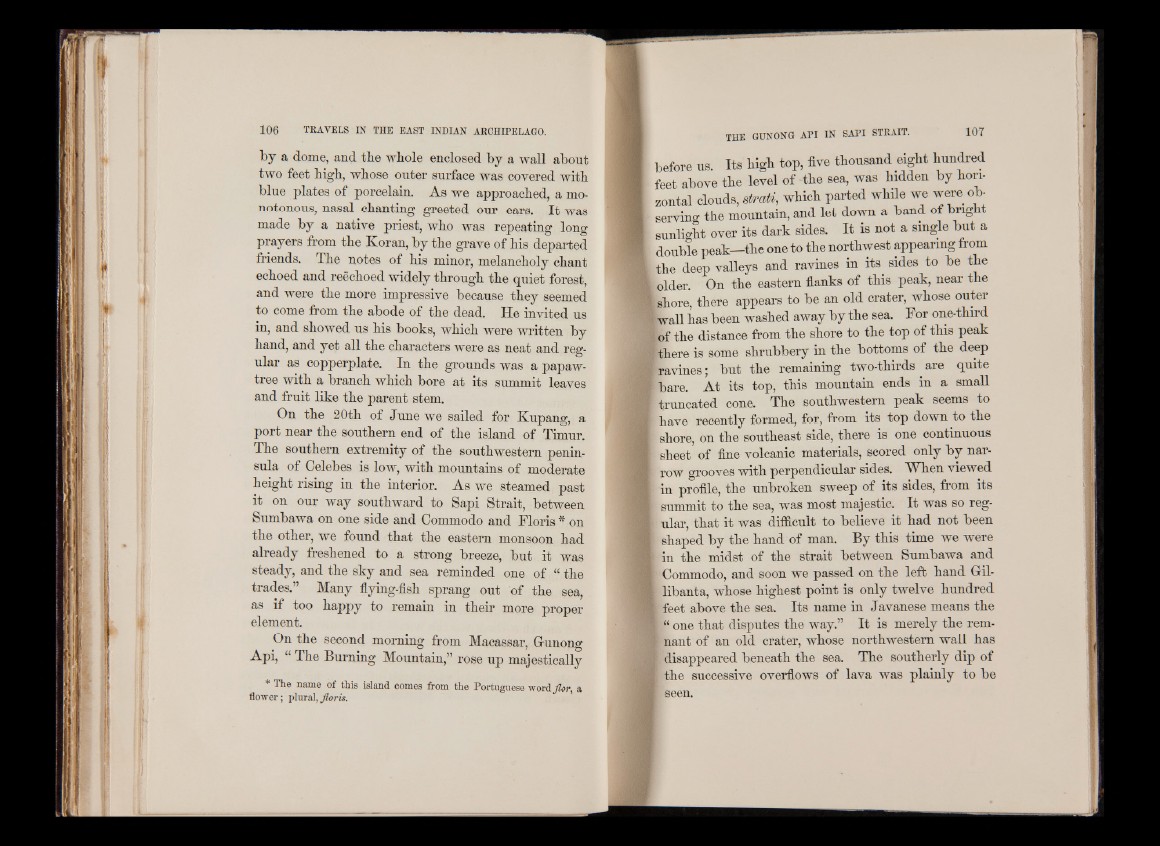
by a dome, and the whole enclosed by a wall about
two feet high, whose outer surface was covered with
blue plates of porcelain. As we approached, a monotonous,
nasal chanting greeted our ears. It was
made by a native priest, who was repeating long
prayers from the Koran, by the grave of his departed
friends. The notes of his minor, melancholy chant
echoed and reechoed widely through the quiet forest,
and were the more impressive because they seemed
to come from the abode of the dead. He invited us
in, and showed us his books, which were written by
hand, and yet all the characters were as neat and regular
as copperplate. In the grounds was a papaw-
tree with a branch which bore at its summit leaves
and fruit like the parent stem.
On the 20th of June we sailed for Kupang, a
port near the southern end of the island of Timur.
The southern extremity of the southwestern peninsula
of Celebes is low, with mountains of moderate
height rising in the interior. As we steamed past
it on our way southward to Sapi Strait, between
Sumbawa on one side and Commodo and Floris * on
the other, we found that the eastern monsoon had
already freshened to a strong breeze, but it was
steady, and the sky and sea reminded one of “ the
trades.” Many flying-fish sprang out of the sea,
as if too happy to remain in their more proper
element.
On the second morning from Macassar, Grunong
Api, “ The Burning Mountain,” rose up majestically
* The name of this island comes from the Portuguese word flor, a
flower; plural,floris.
! before us. Its high top, five thousand eight hundred
< feet above the level of -the sea, was hidden by hon-
I zontal clouds, strati, which parted while we were ob-
| serving the mountain, and let down a band of bright
[ sunlight over its dark sides. It is not a single but a
[ double peak—the one to the northwest appearing from
i the deep valleys and ravines in its^ sides to be the
I older. On the eastern flanks of this peak, near the
I shore’, there appears to be an old crater, whose outer
| wall has been washed away by the sea. For one-third
a of the distance from the shore to the top of this peak
| there is some shrubbery in the bottoms of the deep
I ravines; but the remaining two-thirds ^ are quite
V bare. At its top, this mountain ends in a small
■ truncated cone. The southwestern peak seems to
I have recently formed, for, from its top down to the
I shore, on the southeast side, there is one continuous
I sheet of fine volcanic materials, scored only by nar- I row grooves with perpendicular sides. When viewed
E in profile, the unbroken sweep of its sides, from its
I summit to the sea, was most majestic. It was so reg-
I ular, that it was difficult to believe it had not been
I shaped by the hand of man. By this time we were
I in the midst of the strait between Sumbawa and
I Commodo, and soon we passed on the left hand Gil-
I libanta, whose highest point is only twelve hundred
I feet above the sea. Its name in Javanese means the
I I one that disputes the way.” It is merely the rem-
I nant of an old crater, whose northwestern wall has
I disappeared beneath the sea. The southerly dip of
I the successive overflows of lava was plainly to be
seen.